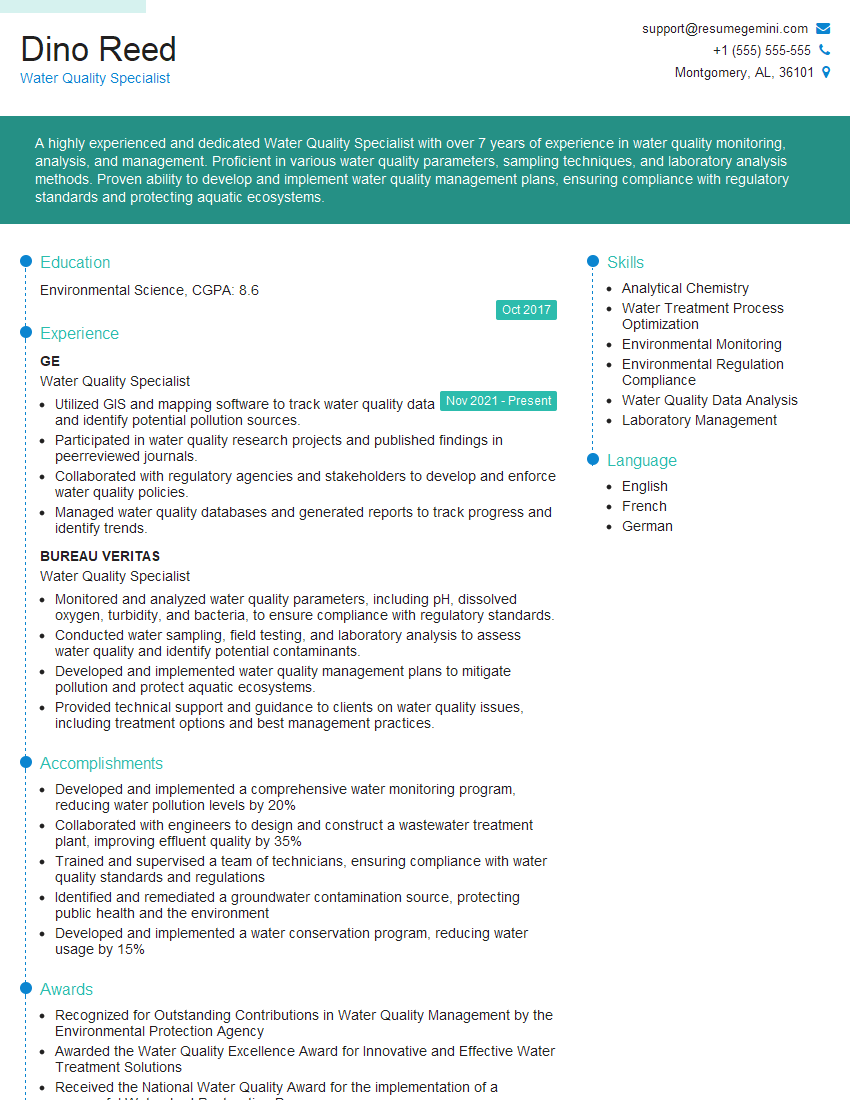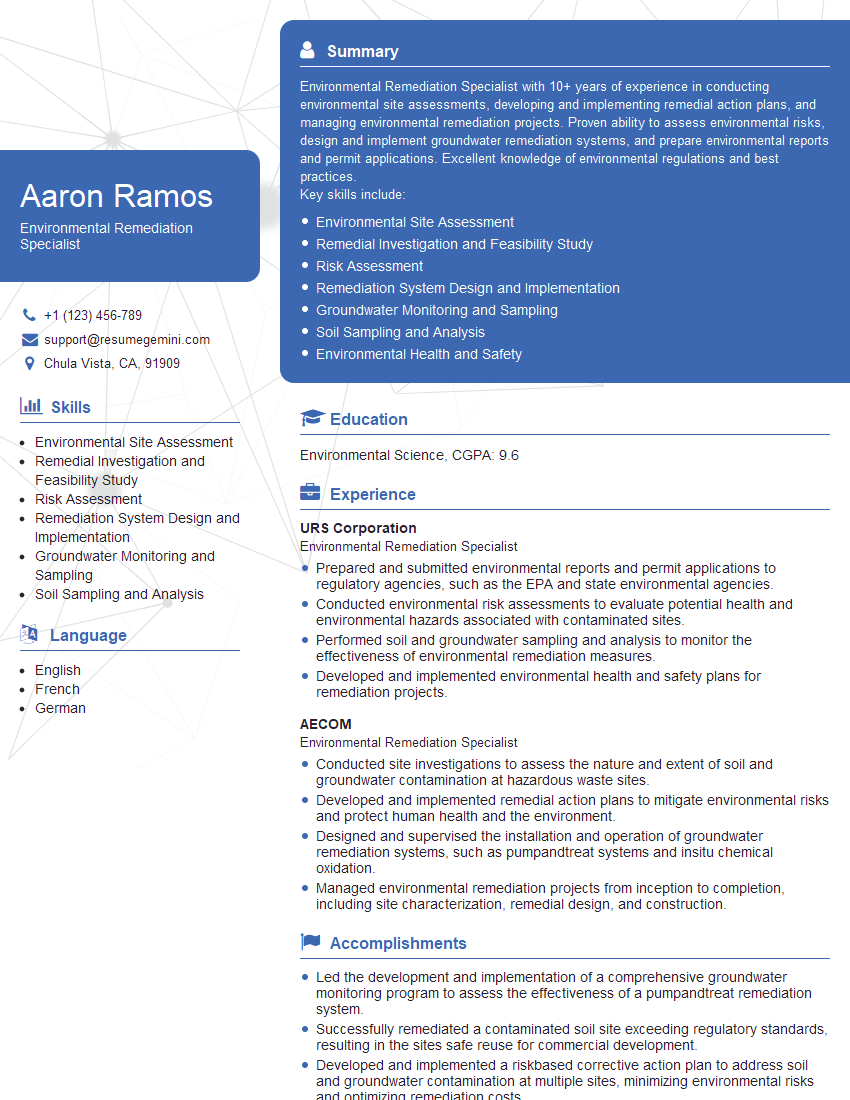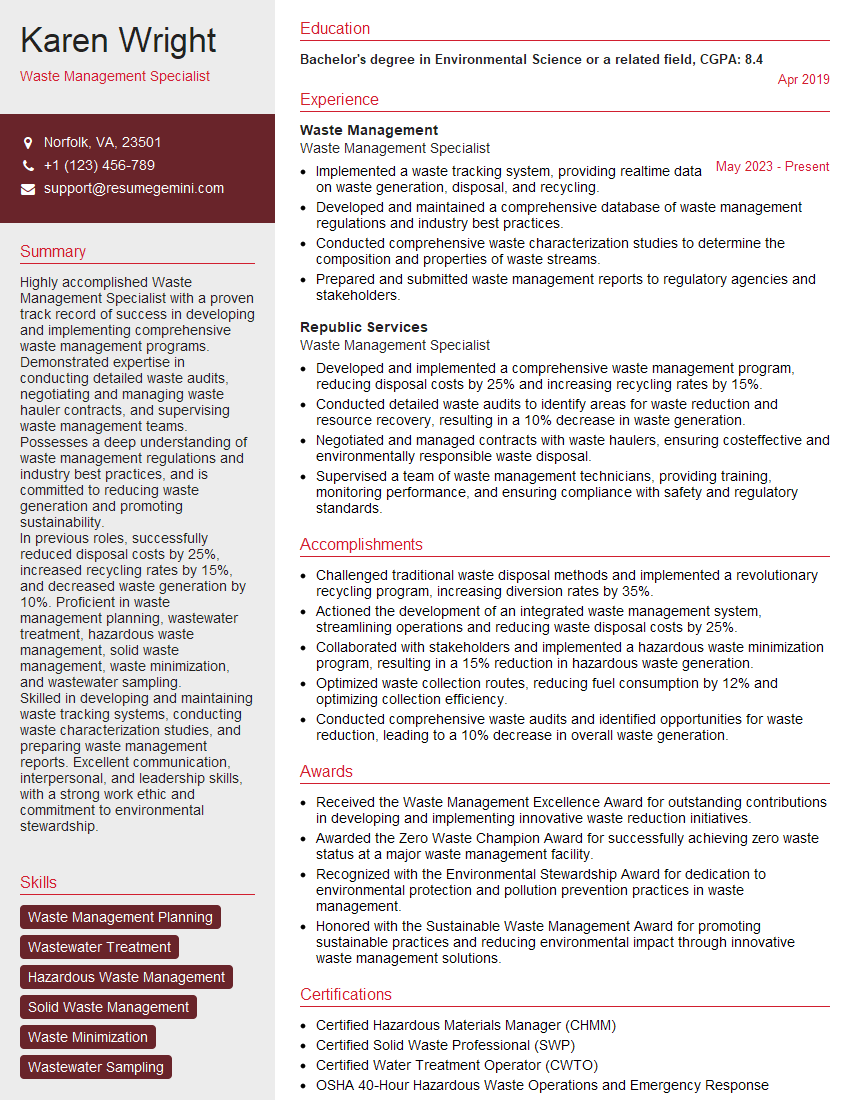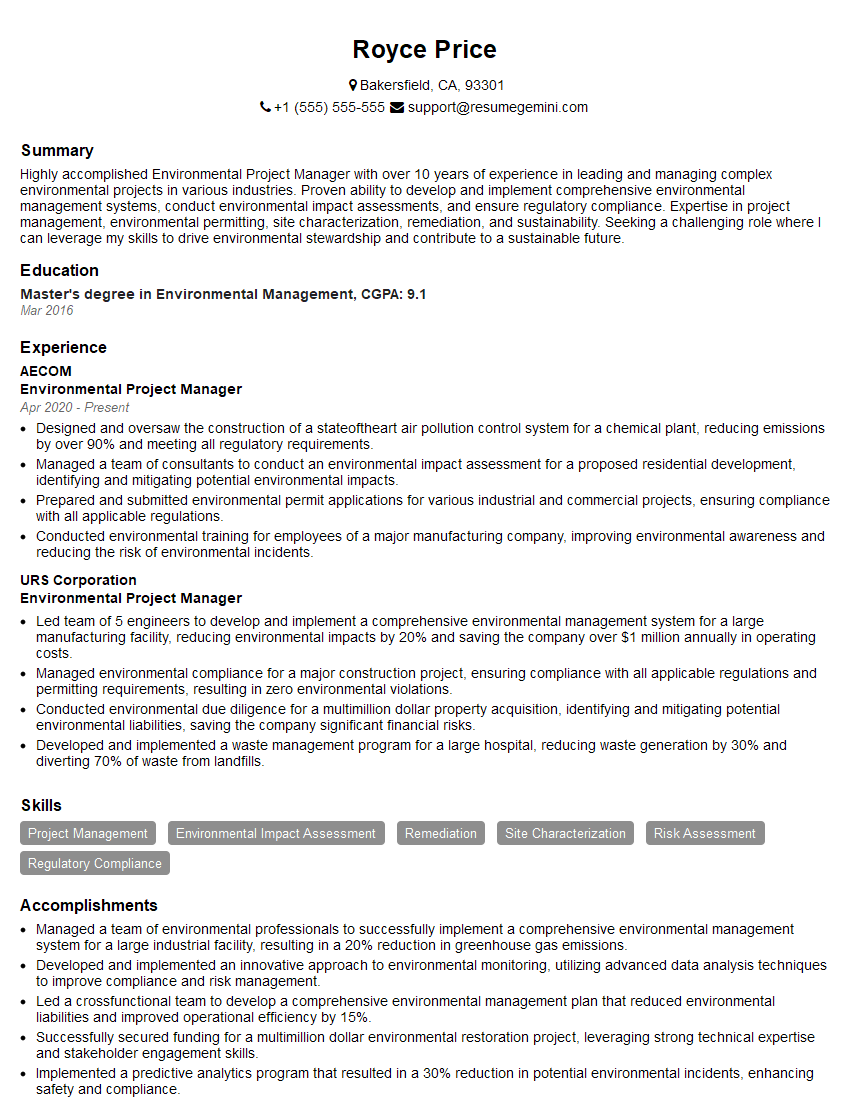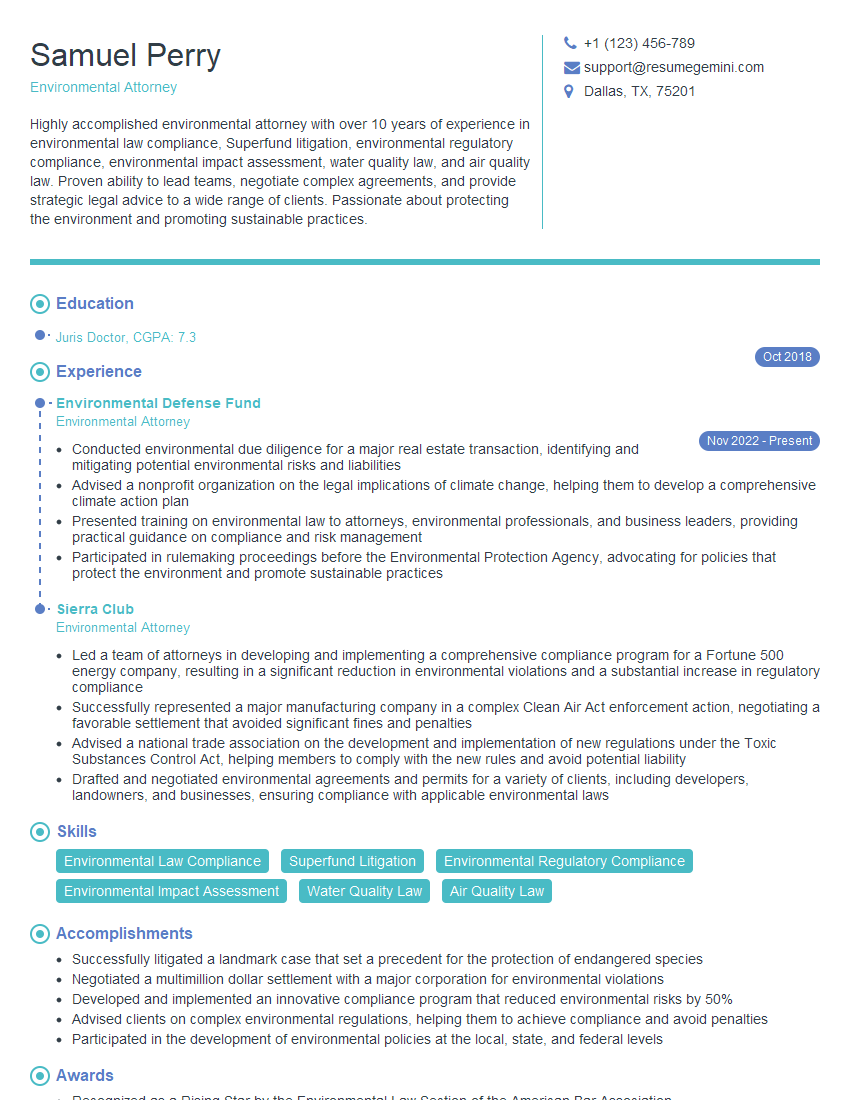The thought of an interview can be nerve-wracking, but the right preparation can make all the difference. Explore this comprehensive guide to EnvironmentalRegulations interview questions and gain the confidence you need to showcase your abilities and secure the role.
Questions Asked in EnvironmentalRegulations Interview
Q 1. Explain the key differences between NEPA and the Clean Water Act.
The National Environmental Policy Act (NEPA) and the Clean Water Act (CWA) are both landmark environmental laws in the United States, but they address different aspects of environmental protection. NEPA is a procedural law, focusing on environmental review, while the CWA is a substantive law, focused on regulation of water pollution.
- NEPA: Requires federal agencies to assess the environmental impacts of their proposed actions before making decisions. This involves preparing Environmental Impact Statements (EIS) for major projects, ensuring consideration of environmental consequences. Think of it as a ‘check-list’ for environmental considerations before a project starts. It doesn’t prohibit projects but ensures they’re evaluated for potential environmental harm.
- CWA: Establishes water quality standards and regulates the discharge of pollutants into US waters. It aims to restore and maintain the chemical, physical, and biological integrity of the nation’s waters. This is a direct regulatory framework with permits and enforcement mechanisms to control water pollution. Think of it as a set of ‘rules of the road’ for maintaining clean water.
In short: NEPA is about process (environmental review), while the CWA is about substance (water quality standards and pollution control).
Q 2. Describe your experience with environmental impact assessments.
I have extensive experience conducting and managing environmental impact assessments (EIAs) for a range of projects, including infrastructure development, mining operations, and industrial facilities. My work typically involves:
- Scoping: Identifying potential environmental impacts and defining the scope of the EIA.
- Data Collection: Gathering baseline data on air and water quality, noise levels, flora, fauna, and socio-economic aspects.
- Impact Prediction: Using various models and techniques to predict the magnitude and significance of potential impacts.
- Mitigation Measures: Developing and evaluating strategies to minimize or avoid adverse impacts.
- Reporting: Preparing comprehensive EIA reports that comply with regulatory requirements and clearly communicate findings to stakeholders.
For example, in one project involving a proposed highway expansion, we identified potential impacts on sensitive wetland ecosystems. Through detailed modeling and consultation with biologists, we developed mitigation measures such as relocating affected species and implementing wetland restoration plans. This resulted in a project design that significantly reduced its ecological footprint.
Q 3. How familiar are you with the process of obtaining environmental permits?
I’m very familiar with the process of obtaining environmental permits. It’s a complex process that varies depending on the type of project and the applicable regulations. However, the general steps usually involve:
- Identifying Applicable Permits: Determining which federal, state, and local permits are required based on the project’s nature and location.
- Permit Application Preparation: Gathering necessary data, completing application forms, and submitting them to the relevant authorities. This often includes detailed engineering plans, environmental impact assessments, and financial assurances.
- Regulatory Review: The permitting agency reviews the application, potentially requesting additional information or clarifications.
- Public Comment Period: Many permitting processes include a public comment period allowing stakeholders to provide input.
- Permit Issuance or Denial: Based on the review, the agency issues the permit with specified conditions or denies the application.
- Permit Compliance: Once a permit is issued, ongoing compliance monitoring is essential to ensure adherence to the permit conditions.
I have successfully navigated this process numerous times, working with agencies like the EPA, Army Corps of Engineers, and state environmental departments to secure permits for various projects. Understanding the specific requirements of each agency and proactively addressing potential concerns during the application phase is crucial for a successful outcome.
Q 4. What are the main components of an environmental management system (EMS)?
An Environmental Management System (EMS) is a structured approach to managing an organization’s environmental performance. It’s a framework for identifying, prioritizing, and addressing environmental aspects of operations. The main components typically include:
- Environmental Policy: A formal statement of the organization’s commitment to environmental protection.
- Planning: Identifying environmental aspects, setting environmental objectives and targets, and developing programs to achieve them.
- Implementation and Operation: Putting the plans into action, allocating resources, training personnel, and establishing operational controls.
- Checking and Corrective Action: Monitoring environmental performance, measuring progress against objectives, and taking corrective action where necessary. This often involves internal audits and management reviews.
- Management Review: Regularly reviewing the EMS’s effectiveness and making improvements.
A well-designed EMS helps organizations minimize their environmental footprint, comply with regulations, and enhance their reputation. Think of it as a continuous improvement cycle for environmental performance.
Q 5. Explain your understanding of the Clean Air Act and its amendments.
The Clean Air Act (CAA) is a US federal law aimed at controlling air pollution. It sets national ambient air quality standards (NAAQS) for criteria pollutants, such as ozone, particulate matter, and sulfur dioxide. These standards define acceptable levels of these pollutants in the ambient air.
Amendments to the CAA have strengthened its provisions over time. Key amendments include:
- 1977 Amendments: Focused on stricter emission standards for new and existing sources, as well as control of hazardous air pollutants (HAPs).
- 1990 Amendments: Introduced a comprehensive program to address acid rain, expanded the regulation of HAPs, and established a market-based approach to reducing sulfur dioxide emissions (the acid rain program).
The CAA employs various strategies to reduce air pollution, including setting emission limits for stationary and mobile sources, requiring the use of pollution control technologies, and implementing emission trading programs. It is a dynamic piece of legislation with ongoing updates and court interpretations shaping its implementation.
Q 6. How do you ensure compliance with environmental regulations in a manufacturing setting?
Ensuring compliance with environmental regulations in a manufacturing setting requires a multifaceted approach. Key steps include:
- Developing a robust EMS: As described earlier, this provides a structured framework for managing environmental performance.
- Conducting regular environmental audits: Identifying potential non-compliance issues before they become problems.
- Implementing effective pollution control technologies: Using appropriate technologies to minimize emissions and discharges.
- Training employees: Ensuring that all personnel understand their responsibilities in relation to environmental compliance.
- Maintaining accurate records: Documenting all environmental activities, including emissions, discharges, and waste management.
- Responding promptly to any non-compliance incidents: Taking immediate action to rectify violations and prevent recurrence.
- Staying updated on changes in regulations: Regularly reviewing and updating environmental management practices to reflect changes in law and best practices.
For example, in a manufacturing plant, I’d ensure proper wastewater treatment is in place and compliant with discharge permits, monitor stack emissions for compliance with air quality standards, and implement a comprehensive waste management plan to minimize hazardous waste generation and properly manage recyclable materials. Proactive monitoring and documentation are key to avoiding costly penalties and maintaining a strong environmental reputation.
Q 7. Describe your experience with environmental audits and inspections.
I possess considerable experience with environmental audits and inspections, both conducting them and undergoing them. My experience encompasses:
- Conducting Audits: I have led numerous environmental audits for various industries, evaluating compliance with environmental regulations, identifying areas of improvement, and recommending corrective actions. This involves reviewing operational records, conducting site inspections, and interviewing personnel.
- Undergoing Inspections: I have worked with regulatory agencies during inspections, providing documentation, answering questions, and addressing any non-compliance findings. A positive and transparent approach is vital during these interactions.
- Developing Corrective Action Plans (CAPs): After identifying non-compliance issues, I have developed and implemented CAPs to address deficiencies and prevent recurrence. This involves creating detailed action plans with timelines and responsibilities.
One notable experience involved an audit where we identified an undocumented discharge of wastewater. Through thorough investigation, we identified the source, implemented corrective measures (including improved piping and monitoring systems), and reported the issue to the regulatory agency. This proactive response minimized environmental harm and demonstrated commitment to compliance. Successful environmental auditing requires both technical knowledge and strong interpersonal skills for effective communication and collaboration.
Q 8. What is your experience with environmental remediation projects?
My experience with environmental remediation projects spans over 15 years, encompassing a wide range of contaminated sites. I’ve been involved in projects ranging from small-scale soil contamination cleanup at industrial facilities to large-scale remediation of groundwater impacted by leaking underground storage tanks (LUST). My expertise includes site assessments, remediation strategy development (including soil vapor extraction, bioremediation, and pump-and-treat systems), regulatory compliance, and project management. For example, I led a team that successfully remediated a site contaminated with trichloroethylene (TCE), reducing the concentration below regulatory limits within two years, significantly improving the local groundwater quality and earning us an environmental award for excellence in remediation. Another project involved developing a phytoremediation strategy for a site contaminated with heavy metals, demonstrating a sustainable and cost-effective approach.
Q 9. How do you handle environmental emergencies and spills?
Handling environmental emergencies and spills requires immediate and decisive action, combining swift response with meticulous regulatory compliance. My approach follows a structured framework: (1) Immediate Containment and Control: This involves swiftly isolating the spill to prevent further spread, using booms, absorbents, and other appropriate containment tools. (2) Notification and Reporting: Immediate notification to relevant authorities (e.g., the National Response Center, state environmental agencies) is crucial, followed by accurate and timely reporting as mandated by regulations. (3) Assessment and Characterization: A thorough assessment of the spill’s extent and the nature of the released substances is conducted to inform the cleanup strategy. (4) Remediation and Cleanup: This stage involves implementing the chosen remediation techniques, ensuring effectiveness and regulatory compliance. (5) Monitoring and Reporting: Post-remediation monitoring is crucial to confirm the effectiveness of the cleanup and to ensure that the site meets regulatory requirements. For instance, I once managed a response to a significant chemical spill at a manufacturing plant, orchestrating the containment, cleanup, and regulatory reporting within the legally mandated timeframe, minimizing environmental damage.
Q 10. What are the key aspects of waste management regulations?
Waste management regulations are multifaceted and aim to minimize environmental impact and promote resource recovery. Key aspects include: (1) Waste Characterization: Accurate identification of waste types (hazardous, non-hazardous, recyclable, etc.) is fundamental to determining appropriate handling and disposal methods. (2) Waste Minimization and Recycling: Regulations encourage waste reduction at the source and prioritize recycling and reuse of materials. (3) Treatment and Disposal: Regulations dictate acceptable methods for treating and disposing of different waste types, including landfills, incineration, and specialized treatment facilities. (4) Transportation and Storage: Strict regulations govern the transportation and storage of waste, including packaging, labeling, and manifest systems to ensure safe handling. (5) Permitting and Monitoring: Facilities handling waste typically require permits, and their operations are subject to regular monitoring and inspections to ensure compliance. These regulations vary based on the type of waste and the jurisdiction. For example, the improper disposal of medical waste could lead to significant health risks and severe penalties.
Q 11. Explain your understanding of hazardous waste regulations.
Hazardous waste regulations are particularly stringent due to the potential for significant environmental and human health risks. These regulations focus on: (1) Identification of Hazardous Waste: Regulations define hazardous waste based on its characteristics (e.g., ignitability, corrosivity, reactivity, toxicity) or its listing on specific regulatory lists. (2) Cradle-to-Grave Management: Regulations track hazardous waste from its generation to its final disposal, emphasizing responsible handling throughout its entire lifecycle. (3) Treatment, Storage, and Disposal Facilities (TSDFs): Strict permitting requirements and operational standards are applied to facilities handling hazardous waste. (4) Manifest System: A rigorous tracking system uses manifests to document the movement of hazardous waste from generation to disposal. (5) Emergency Preparedness and Response: Facilities must have plans in place to handle accidental releases or spills of hazardous waste. Non-compliance can result in significant fines and legal action. A common example is the stringent regulations surrounding the handling and disposal of PCB-contaminated materials, requiring specialized disposal methods and careful monitoring.
Q 12. How familiar are you with the Resource Conservation and Recovery Act (RCRA)?
The Resource Conservation and Recovery Act (RCRA) is the cornerstone of hazardous and non-hazardous waste management in the United States. My understanding of RCRA is comprehensive, encompassing its key aspects: (1) Subtitle C: Governs the management of hazardous waste, encompassing generation, transportation, treatment, storage, and disposal. (2) Subtitle D: Addresses the management of non-hazardous solid waste, including landfill regulations. (3) Underground Storage Tanks (USTs): RCRA regulates the installation, operation, monitoring, and closure of USTs to prevent groundwater contamination. (4) Permitting and Compliance: RCRA establishes a permitting process for facilities managing hazardous waste and mandates compliance monitoring. I have extensive experience interpreting and applying RCRA requirements in various contexts, ensuring compliance for numerous projects.
Q 13. Describe your experience with environmental monitoring and reporting.
Environmental monitoring and reporting are essential for demonstrating compliance with environmental regulations and assessing the effectiveness of remediation efforts. My experience involves designing and implementing monitoring plans, collecting samples (water, soil, air), conducting laboratory analyses, interpreting data, and preparing comprehensive reports to regulatory agencies. I’m proficient in using various monitoring technologies and data analysis tools. For instance, I developed a long-term groundwater monitoring program for a site undergoing remediation, tracking contaminant concentrations over time to demonstrate the effectiveness of the cleanup and submit regular reports to the EPA. This involved meticulous data analysis to identify trends, assess compliance with regulatory limits and support decision-making concerning the project’s timeline and resource allocation.
Q 14. How do you stay up-to-date with changes in environmental regulations?
Staying current with evolving environmental regulations is crucial in this field. My approach is multi-pronged: (1) Professional Organizations: Active membership in organizations like the Environmental Professionals Association keeps me updated on legislative changes and emerging best practices. (2) Regulatory Websites: Regularly reviewing the websites of relevant regulatory agencies (EPA, state environmental agencies) ensures I’m aware of rule changes and guidance updates. (3) Industry Publications and Conferences: Attending conferences and reading specialized journals helps me stay abreast of new research, technologies, and regulatory interpretations. (4) Continuing Education: I regularly participate in professional development courses and workshops to maintain my expertise and stay current with advancements in environmental regulations. For example, the recent updates to regulations on PFAS (per- and polyfluoroalkyl substances) necessitated my immediate review and incorporation of these changes in my professional practice.
Q 15. What is your experience with environmental data analysis and reporting?
My experience with environmental data analysis and reporting spans over 10 years, encompassing diverse projects ranging from air quality assessments to greenhouse gas emissions inventories. I’m proficient in utilizing statistical software like R and Python to analyze complex datasets, identifying trends and patterns critical for informed decision-making. For instance, in a recent project for a manufacturing plant, I analyzed their wastewater discharge data to identify peak pollution periods and recommend process adjustments to improve compliance. My reports are meticulously structured, incorporating clear visualizations such as charts and maps to effectively communicate complex findings to both technical and non-technical audiences. I ensure data accuracy, validity, and reliability by employing rigorous quality control measures throughout the analysis process. This includes using established methodologies, conducting sensitivity analyses, and documenting all procedures meticulously.
Beyond data analysis, I have considerable experience in preparing comprehensive environmental reports adhering to various regulatory frameworks like the Environmental Protection Agency’s (EPA) guidelines. This includes preparing permit applications, environmental impact assessments, and compliance reports tailored to specific regulatory requirements and stakeholder needs.
Career Expert Tips:
- Ace those interviews! Prepare effectively by reviewing the Top 50 Most Common Interview Questions on ResumeGemini.
- Navigate your job search with confidence! Explore a wide range of Career Tips on ResumeGemini. Learn about common challenges and recommendations to overcome them.
- Craft the perfect resume! Master the Art of Resume Writing with ResumeGemini’s guide. Showcase your unique qualifications and achievements effectively.
- Don’t miss out on holiday savings! Build your dream resume with ResumeGemini’s ATS optimized templates.
Q 16. Describe your experience with stakeholder engagement related to environmental issues.
Stakeholder engagement is crucial for successful environmental management. My approach emphasizes building strong, trusting relationships with diverse stakeholders, including government agencies, community members, industry representatives, and NGOs. I believe in transparent and open communication, ensuring all stakeholders are informed and involved throughout the process. For example, during a project involving a proposed landfill site, I facilitated a series of public forums to address community concerns regarding potential environmental impacts. These forums involved interactive sessions, Q&A periods, and opportunities for feedback, culminating in a mutually agreed-upon mitigation plan that addressed the community’s apprehensions.
Effective engagement involves active listening, understanding diverse perspectives, and finding common ground. I use a variety of communication methods tailored to each stakeholder group, from technical reports and presentations to less formal meetings and workshops. Ultimately, my goal is to foster collaboration and build consensus around environmentally sound solutions.
Q 17. How do you prioritize competing environmental compliance requirements?
Prioritizing competing environmental compliance requirements involves a systematic approach. I typically begin by identifying all applicable regulations and deadlines. Then, I assess the potential environmental and financial consequences of non-compliance for each requirement, considering factors such as the severity of potential violations, the likelihood of detection, and the associated penalties. A risk matrix is often helpful in this process, assigning a level of risk to each requirement based on its potential impact and probability of occurrence.
Once the risks are assessed, I prioritize requirements based on their level of risk, allocating resources accordingly. Requirements with higher risks, such as those with significant environmental consequences or substantial penalties for non-compliance, are addressed first. This prioritization process often involves collaboration with management to ensure alignment with business objectives and resource constraints. Clear documentation of the prioritization process is crucial for transparency and accountability.
Q 18. What is your approach to risk assessment and management in an environmental context?
My approach to risk assessment and management in an environmental context follows a structured framework, often incorporating the principles of ISO 31000. This begins with identifying potential environmental hazards and vulnerabilities, such as pollution events, natural disasters, or regulatory changes. I then analyze the likelihood and potential impact of each hazard, using both qualitative and quantitative methods. This might include reviewing historical data, conducting site inspections, and employing modeling techniques to predict potential impacts.
Once the risks are identified and assessed, I develop a risk mitigation plan, outlining specific strategies to reduce or eliminate the identified risks. These strategies can range from implementing engineering controls and administrative procedures to procuring insurance and developing emergency response plans. The effectiveness of the mitigation plan is regularly monitored and reviewed, with adjustments made as needed. The entire process is thoroughly documented, ensuring transparency and accountability.
Q 19. Explain your understanding of environmental sustainability principles.
Environmental sustainability principles guide my work. I understand that sustainability encompasses three core pillars: environmental protection, social equity, and economic viability. These principles are interconnected; a truly sustainable solution must balance environmental protection with social well-being and economic considerations. For example, a project that minimizes environmental impact but displaces a community is not truly sustainable.
In practice, I strive to incorporate these principles into all my work by promoting resource efficiency, pollution prevention, waste minimization, and the use of renewable resources. I also consider the social and economic impacts of my recommendations, working to ensure that environmental improvements benefit communities and enhance long-term economic prosperity. A life-cycle assessment (LCA) is frequently utilized to evaluate the full environmental impact of a product, process, or project across its entire life cycle from cradle to grave.
Q 20. How do you incorporate environmental considerations into project planning?
Incorporating environmental considerations into project planning is crucial for ensuring a project’s environmental sustainability and compliance. I integrate environmental considerations from the very outset of the project planning stage. This involves conducting an initial environmental screening to identify potential environmental impacts and applicable regulations. Next, a comprehensive environmental impact assessment is undertaken, predicting and evaluating potential environmental risks, identifying mitigation measures, and developing a robust environmental management plan.
The environmental management plan becomes an integral part of the overall project plan, outlining specific actions, responsibilities, and timelines for implementing mitigation measures and ensuring ongoing compliance. Regular monitoring and reporting are essential to track progress and make necessary adjustments throughout the project lifecycle. This proactive approach ensures that environmental considerations are not an afterthought but an integral component of project success.
Q 21. Describe a time you had to resolve a conflict related to environmental regulations.
In a previous project involving the construction of a new industrial facility, a disagreement arose between the project developers and local environmental groups concerning the location of a proposed wastewater discharge pipe. The environmental groups argued that the proposed location could negatively impact a sensitive wetland area. To resolve this conflict, I facilitated a series of meetings involving all stakeholders, fostering open communication and a collaborative problem-solving approach. We explored alternative piping routes, assessing their feasibility and environmental impact.
Ultimately, we reached a compromise that involved slightly modifying the pipe’s location to minimize impact on the wetland, incorporating additional environmental monitoring, and establishing a community oversight committee to ensure ongoing compliance. This experience highlighted the importance of clear communication, compromise, and collaboration in resolving environmental conflicts. By prioritizing transparency and seeking mutually acceptable solutions, we successfully navigated the disagreement and ensured project completion while mitigating potential environmental damage.
Q 22. What is your understanding of the concept of environmental justice?
Environmental justice is the fair treatment and meaningful involvement of all people regardless of race, color, national origin, or income, with respect to the development, implementation, and enforcement of environmental laws, regulations, and policies.
It recognizes that environmental hazards disproportionately affect marginalized communities. For example, a polluting factory located near a low-income, predominantly minority neighborhood demonstrates environmental injustice. These communities often lack the resources to fight for their rights and bear the brunt of pollution’s health consequences.
Addressing environmental justice requires proactive measures like equitable siting of facilities, community engagement in decision-making processes, and enforcement of environmental regulations to protect vulnerable populations.
Q 23. How familiar are you with international environmental agreements?
I’m very familiar with numerous international environmental agreements. My knowledge spans agreements addressing climate change (like the Paris Agreement), biodiversity (Convention on Biological Diversity), hazardous waste (Basel Convention), and transboundary pollution (various regional agreements).
I understand the complexities of these agreements, including their legal frameworks, compliance mechanisms, and the challenges in achieving global cooperation. For instance, the Paris Agreement’s success hinges on each nation’s commitment to reducing emissions, a process complicated by differing national priorities and economic conditions. My experience includes analyzing the implications of these agreements on businesses operating internationally, ensuring compliance, and identifying opportunities for sustainable practices.
Q 24. Describe your experience with environmental due diligence.
Environmental due diligence is a critical process of identifying and assessing potential environmental liabilities associated with a property or business transaction. My experience includes conducting Phase I, II, and III environmental site assessments, reviewing environmental permits and compliance records, and analyzing potential risks and costs associated with environmental contamination.
For example, I once worked on a due diligence project for a client considering acquiring a manufacturing plant. Our assessment revealed past soil contamination. This finding allowed the client to negotiate a reduced purchase price or even walk away from the deal, avoiding substantial remediation costs. This highlights the importance of thorough due diligence in minimizing financial and legal risks.
I am proficient in interpreting environmental reports, evaluating remediation strategies, and advising clients on the best course of action to mitigate environmental liabilities.
Q 25. How do you ensure accurate and timely reporting of environmental data?
Accurate and timely environmental data reporting is paramount. My approach involves a multi-step process:
- Data Collection: Establishing robust monitoring systems, using calibrated equipment, and employing standardized data collection procedures.
- Data Validation: Implementing quality control checks to ensure data accuracy and consistency, including cross-referencing and audits.
- Data Analysis: Employing statistical methods and data visualization tools to identify trends and anomalies.
- Reporting: Utilizing established reporting formats, adhering to regulatory requirements, and employing clear and concise language.
- Technology:Leveraging environmental management software (discussed further in question 7) for streamlined data management and reporting.
Regular internal audits and external verification enhance the reliability of our reporting process.
Q 26. What are your strategies for implementing and maintaining an effective EMS?
Implementing and maintaining an effective Environmental Management System (EMS) follows a structured approach based on the ISO 14001 standard (or equivalent). This involves:
- Establishing Environmental Policy: Defining clear environmental objectives and targets.
- Planning: Identifying significant environmental aspects, assessing environmental risks, and developing control measures.
- Implementation and Operation: Training employees, implementing operational controls, and documenting procedures.
- Monitoring and Measurement: Tracking environmental performance indicators and identifying areas for improvement.
- Review and Improvement: Conducting regular management reviews and implementing corrective and preventive actions.
Continuous improvement is crucial. Regular performance evaluations and stakeholder engagement are critical for an EMS to remain effective and relevant.
Q 27. How do you communicate complex environmental issues to non-technical audiences?
Communicating complex environmental issues to non-technical audiences requires simplifying the information without sacrificing accuracy. I employ several strategies:
- Analogies and Metaphors: Relating environmental concepts to everyday experiences to foster understanding.
- Visual Aids: Using graphs, charts, and images to present data effectively.
- Storytelling: Using real-world examples to illustrate the impacts of environmental issues.
- Plain Language: Avoiding jargon and technical terms; defining terms when necessary.
- Active Listening and Feedback: Engaging the audience and addressing their questions and concerns.
For example, when explaining carbon footprints, I might use the analogy of a bathtub filling up with water, representing greenhouse gas emissions.
Q 28. Describe your experience using environmental management software.
I have extensive experience using various environmental management software packages, including Envizi, Intelex, and EHS Insight. My expertise extends to data entry, report generation, compliance tracking, and performance monitoring within these systems.
These software solutions streamline data management, enhance compliance efforts, and provide valuable insights into environmental performance. For example, using Envizi, we can track emissions across multiple facilities, analyze trends, and generate comprehensive sustainability reports, ensuring data accuracy and facilitating efficient compliance.
Key Topics to Learn for Environmental Regulations Interview
- Environmental Impact Assessments (EIAs): Understanding the process, methodologies, and potential challenges in conducting and interpreting EIAs. This includes familiarity with different assessment frameworks and legal requirements.
- Pollution Control Technologies and Strategies: Knowledge of various technologies used to mitigate air, water, and soil pollution, along with their practical applications in different industrial sectors. Consider case studies demonstrating successful implementation.
- Environmental Legislation and Compliance: Familiarity with key environmental laws and regulations (mention relevant national or regional legislation if applicable, e.g., Clean Air Act, Clean Water Act). This includes understanding permit applications, compliance monitoring, and enforcement procedures.
- Sustainable Development Principles: Grasping the core concepts of sustainable development and their integration into environmental regulations and policy. Explore the relationship between economic growth, social equity, and environmental protection.
- Environmental Auditing and Reporting: Understanding the process of conducting environmental audits, interpreting results, and preparing compliance reports. This includes familiarity with relevant reporting frameworks and standards.
- Climate Change Mitigation and Adaptation: Knowledge of climate change policies, regulations, and strategies. This includes carbon accounting, emissions reduction technologies, and adaptation measures for climate-related risks.
- Waste Management and Recycling: Understanding different waste management approaches, recycling technologies, and the regulatory framework governing waste disposal and recycling.
- Environmental Risk Assessment and Management: Ability to identify, assess, and manage environmental risks associated with various projects and activities. This includes understanding risk assessment methodologies and mitigation strategies.
Next Steps
Mastering Environmental Regulations is crucial for career advancement in this critical field. A strong understanding of these principles demonstrates your commitment to sustainability and opens doors to diverse and impactful roles. To maximize your job prospects, creating an ATS-friendly resume is essential. ResumeGemini is a trusted resource that can help you build a professional and effective resume tailored to the specifics of your Environmental Regulations experience. Examples of resumes tailored to this field are available to guide you through the process. Invest time in crafting a compelling resume – it’s your first impression to potential employers.
Explore more articles
Users Rating of Our Blogs
Share Your Experience
We value your feedback! Please rate our content and share your thoughts (optional).
What Readers Say About Our Blog
good

